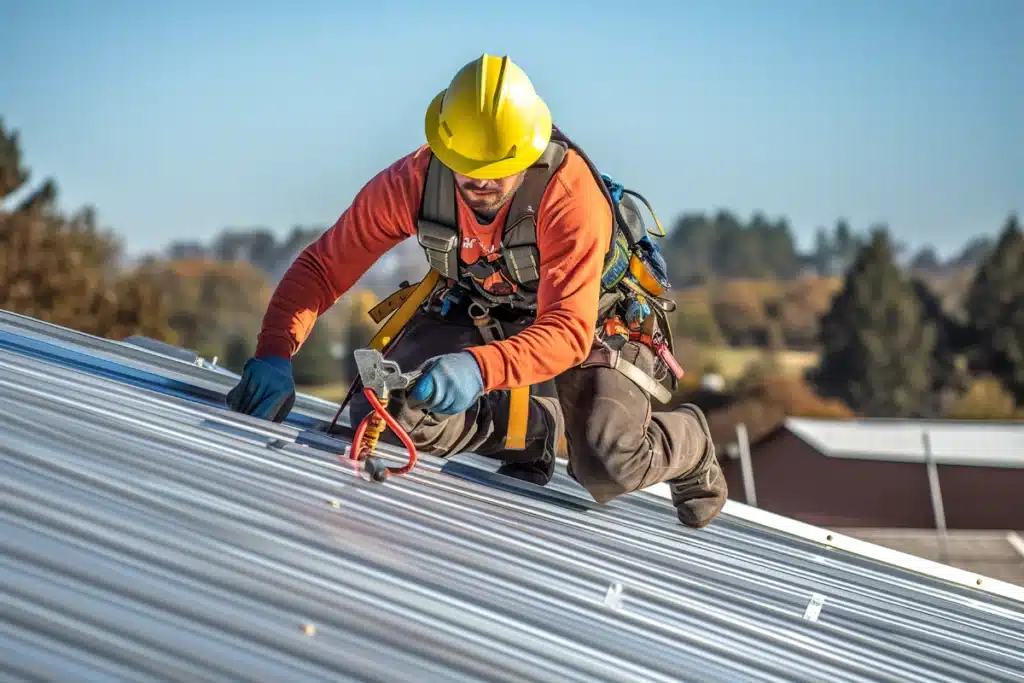Seasonal Roof Covering Fixing Checklist: Prepare Your Roof Covering for each Climate
As a homeowner, you know the importance of securing your financial investment, and your roof covering plays an important function in that. Each period brings distinct difficulties that can affect its integrity. By following a seasonal roofing fixing checklist, you can stay ahead of prospective problems. From winter season ice dams to summer warmth, each step is significant. Let's discover just how correct maintenance can secure your home and extend your roof covering's life-span.
Evaluating Your Roof for Winter Season Readiness
As winter season techniques, it's important to examine your roof covering to confirm it can endure harsh climate condition. Begin by examining for missing or harmed roof shingles; even a small concern can bring about significant leakages when snow and ice gather. Next, check out the blinking around vents and chimneys-- this area is commonly vulnerable to water invasion.
Do not neglect to look for indicators of sagging or unequal surfaces, as these might indicate structural problems. Furthermore, verify your seamless gutters are clear; blocked rain gutters can bring about ice dams that damage your roof covering.
 roof repair
roof repair
Spring Cleaning: Clearing Debris and Checking for Damages
When winter season's grip launches, it's time to tackle spring cleaning on your roof covering by removing debris and looking for any type of damages. Beginning by inspecting your roof for dropped branches, leaves, and various other particles that can trap wetness and cause rot. A tidy roof promotes much better water drainage and prevents mold growth.
Following, get hold of a strong ladder and meticulously check shingles for splits or missing pieces. Focus on areas around chimneys and vents, as these spots are vulnerable to leakages. Don't neglect to analyze your gutters, guaranteeing they're without obstructions that could bring about water pooling.
While you're up there, seek indicators of wear, like corrosion on steel blinking or loose seals around skylights. If you find any kind of issues, addressing them currently can save you from costly repair services later. A little springtime cleaning goes a lengthy means in preserving your roof's honesty.
Summer Heat: Analyzing Your Roofing for Heat-Related Issues
As summertime heat magnifies, it's necessary to evaluate your roofing for heat-related problems. Look for any kind of tile damage, try to find indicators of warm buckling, and evaluate exactly how well your roofing ventilates. Taking these steps currently can prevent larger troubles later on.
Inspect for Shingle Damages
 roof repair
roof repair
Look For Warmth Fastening
Warm fastening is a common issue that can develop during the scorching summer months, and it's important to examine for it on your roofing system. Beginning by evaluating your roof visually; look for any kind of unequal surface areas or lifted sides. If you detect any indications of warmth buckling, it's essential to address them quickly to avoid further damages.
Review Roof Ventilation Performance
After inspecting for warmth fastening, it's crucial to examine your roofing's air flow effectiveness. Correct air flow helps regulate temperature level and wetness, stopping damage from too much heat. Bear in mind, preserving good air flow not only lengthens your roof's life but likewise enhances your home's general power efficiency, ensuring comfort throughout those warm summer season months.
Rainy Period Preparedness: Ensuring Correct Drain
As the rainy season strategies, you require to ensure your roof's drain system is prepared to handle heavy rainstorms. Begin by checking your seamless gutters and downspouts, and see to it they're free from debris. Do not fail to remember to examine the blinking and seals to stop leakages and water damages.
Evaluate Downspouts and gutters
Throughout the stormy period, it is critical to consistently check your downspouts and seamless gutters to ensure correct drainage. Start by examining for any type of visible particles, like leaves or twigs, that could block the flow of water. Make certain the gutters are firmly connected and devoid of sagging, as this can catch water and result in leaks. Next off, take a look at the downspouts for obstructions or damages; a blocked downspout can create water to overflow, potentially harmful your roof and foundation. Validate that downspouts straight water away from your home's structure. Resolve them immediately to prevent costly fixings if you spot any kind of issues. When heavy rainfalls hit., a little maintenance now can conserve you huge frustrations later on.
Tidy Roofing System Surface Area Particles
To guarantee your roof covering can manage the wet period, it's necessary to clean up any type of debris from the surface area routinely. Leaves, branches, and dirt can build up, obstructing water drainage paths and causing water to swimming pool. This trapped water can result in leakages and damage gradually. Order a strong ladder and inspect your roof covering for any type of build-up. Make use of a roofing rake or broom to gently remove debris, being careful not to harm the roof shingles. Do not neglect to check your gutters also, ensuring they're clear and functioning effectively. After cleaning, monitor your roofing after heavy rainfalls to find any kind of possible issues early. Keeping your roof covering free from debris is important for protecting against expensive repair work down the line.
Examine Flashing and Seals
After removing your roof covering of debris, take a better look at the flashing and seals around chimneys, skylights, and vents. If you see any kind of damages, it's important to repair or change it promptly. Guaranteeing these components are in good problem will certainly help preserve proper water drainage and protect your home from water damages throughout hefty rains.
Checking and Keeping Roof Covering Seals and Flashing
While it might appear very easy to ignore, keeping and examining roof covering seals and flashing is essential for avoiding leaks and water damages. Begin by inspecting the seals around chimneys, vents, and skylights. Search for any kind of cracks, spaces, or indications of wear. It's finest to reseal them with proper roof sealant to guarantee a tight fit. if you find any type of problems.
Following, analyze the blinking, which directs water away from critical areas. Look for rust, loosened sections, or bent edges. https://buffalocreekpress.com/ll-roofing-delivering-excellence-in-roofing-solutions-for-gainesville-and-beyond/ Change it or protect it correctly to maintain its integrity if you locate any damaged flashing. Bear in mind, also a little problem can bring about considerable problems in the future.
Last but not least, don't forget to clean off any kind of debris that could block the seals or blinking. Keeping these elements healthy will help secure your roof versus the elements and extend its lifespan.
Gutter Upkeep: Maintaining Water Streaming Efficiently
Considering that your rain gutters play an important function in directing rain away from your home, regular maintenance is important for stopping water damage and structure problems. A clogged up gutter can lead to water overflow, which may damage your roof covering and house siding.
If you see any kind of damage, repair work or replace the damaged parts promptly. Confirm downspouts are routing water at the very least 6 feet away from your foundation.
Ultimately, check that your seamless gutters are properly sloped, preferably a quarter inch for every 10 feet. This slope warranties water moves efficiently towards the downspouts. Normal maintenance will certainly maintain your rain gutters functioning successfully and safeguard your home from costly repairs.
Arranging Professional Assessments for Comprehensive Care
Consistently organizing expert evaluations is crucial for keeping your roof's integrity. These professionals can spot possible issues before they become expensive fixings. Objective for at least 2 inspections a year-- one in the springtime and an additional in the fall. This timing enables you to deal with any type of damage triggered by winter climate or summertime storms.
Throughout inspections, specialists will evaluate roof shingles, flashing, and air flow, ensuring every little thing's in leading shape. They'll also examine for signs of wear, leakages, or mold, which you may overlook. Scheduling these examinations not only prolongs your roof covering's life-span yet also offers you satisfaction.
If you're uncertain concerning the problem of your roof, do not be reluctant to call a specialist. Buying these exams now can save you a great deal later. Prioritize your roofing's wellness, and you'll be well-prepared for whatever climate comes your way.
Regularly Asked Questions
Exactly how Usually Should I Examine My Roof Covering Throughout the Year?
You should examine your roof at the very least twice a year, ideally in springtime and loss. After serious weather condition events, check for damage too. Regular evaluations help you catch concerns early and save cash on fixings.
What Indications Show I Required a Roof Substitute Rather Than Fixing?
 roof repair
roof repair
Can I Execute Roofing System Repair Works Myself, or Should I Employ an Expert?
You can perform minor roofing repairs yourself if you fit with elevations and fundamental devices, but employing an expert warranties security and proper work. Do not take the chance of damages; it may be worth the financial investment for comfort.
What Are the most effective Materials for Roof Services in Different Environments?
For different environments, you'll desire materials like asphalt tiles for modest areas, metal roof covering for extremes, and clay floor tiles for warm regions. Always think about regional climate patterns to ensure your roofing system withstands the aspects successfully.
How Do Roofing Guarantees Affect Seasonal Upkeep Responsibilities?
Roof service warranties typically define upkeep obligations, so you'll need to review the terms. If you don't keep your roofing system as called for, you may invalidate the warranty, leaving you in charge of expensive fixings.
Seasonal Roof Repair List: Prepare Your Roof Covering for Every Weather
As soon as wintertime's hold releases, it's time to deal with spring cleaning on your roof covering by getting rid of away particles and checking for any type of damage. Inspect for any kind of tile damages, look for signs of warm fastening, and review exactly how well your roofing system aerates. If you detect any problems, take into consideration calling an expert for repair services to maintain your roof in leading shape and secure your home from potential water damages.
While it may appear simple to overlook, preserving and checking roof seals and flashing is necessary for preventing leakages and water damages.